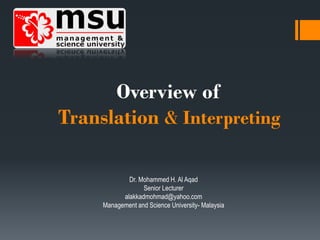
Overview of translation and interpretation
- 1. Overview of Translation & Interpreting Dr. Mohammed H. Al Aqad Senior Lecturer alakkadmohmad@yahoo.com Management and Science University- Malaysia
- 2. A glance at its history Consecutive interpretation was the first mode of interpretation widely used at international meetings. Some of the finest moments in consecutive interpreting occurred at the time of the Paris Peace Conference and in the meetings of the League of Nations at the end of the World War I. The pioneers of this method were Paul Mantoux, Antoine Velleman, Jean Herbert, amongst others. By the late 1940s, simultaneous interpretation became the most used method in the meetings of the main bodies of the United Nations. Today, staff interpreters provide consecutive interpretation for meetings of Heads of State or high government officials with Secretary-General, Presidents of the Security Council etc.
- 3. Interpreting A term used to refer to the oral translation of a spoken message or text. Interpreting or interpretation: The term interpretation is often used interchangeably with interpreting, yet some writers insist that the former term should be avoided in this context. The retention of a distinction between these two notions is particularly necessary in the case of court interpreting, where interpretation in the sense of “conveying one’s understanding of meanings and intentions” is an activity which interpreters are supposed to avoid.
- 4. History The history of interpreting is not well documented, although it is generally agreed that as an activity it is older than written translation.
- 5. Differences between interpreting and translation The communication skills which it requires are clearly different, as interpreters need to be expert oral communicators(speakers). While translators often have relatively unlimited opportunities to make alterations and improvements before submitting a final version, interpreters are required to create a finished product in “real time” without the possibility of going back and making revisions; in other words, interpreting, unlike written translation, is both non- CORRECTABLE and non- VERIFIABLE.
- 6. Interpreters must ensure that any background knowledge which they are likely to need has been acquired in advance; seeking “colleague advice” or consulting reference works is not generally possible during the actual process of interpreting. Interpreters are “performers” who are constantly making split –second decisions and taking communicative risks; consequently they typically experience higher stress levels while “on the job ” than most translators.
- 7. Types of interpreting Various types of interpreting can be distinguished, either by the context in which it occurs (e.g. community interpreting ,conference interpreting and court interpreting) or the way in which it is carried out; in other words, methods ( e.g. consecutive interpreting ,liaison interpreting, simultaneous interpreting and whispered interpreting), although clearly there is a considerable amount of overlap between some of these categories; however, one further type which is significantly different from others is signed language interpreting, since this involves both oral and visual-gestural modalities.
- 8. Types of interpreting in terms of context of use 3.Court interpreting 2.Conference interpreting 1.Community interpreting
- 9. Community (Dialogue interpreting or public service interpreting) It takes place in the public service sphere to facilitate communication between officials and lay people. Its purpose is to provide access to a public service for a person who does not speak the majority language of the community which he or she lives; the settings in which it is used include ” police, legal encounters, schools, public safety, employment interviews and health care settings.” It normally occurs in one-to-one setting and tends to be bi- directional ; it is generally performed consecutively. It covers both face -to-face situations and interpreting over the telephone and is probably the most common type of interpreting in the world.
- 10. Conference A term used to refer to the type of interpreting which occurs in international conferences as well as other high- profile settings such as lectures, television broadcasts or summit meetings. The role of conference interpreters is one of mediating between a knowledgeable speaker and his or her audience; problems sometimes arise since interpreters cannot always be expected to share the knowledge background which a speaker’s audience is assumed to possess. Conference interpreters need to be proficient in interpreting techniques.
- 11. Court The term is widely used to refer to any kind of legal interpreting, but the courtroom is in fact only one of several contexts in which legal interpreting may take place. It has come to occupy higher position than other types of legal interpreting. What most distinguishes court interpreting from other types of interpreting is its close attention to ethical issues which arise from the function of the courtroom. In terms of interpreting strategies, this tends to be reflected in an insistence on fidelity, impartiality and confidentiality.
- 12. • Does not require any specialized vocabulary. • Requires the knowledge of: 1- current events and trends. 2-the topic the interpreter might be asked to convert. General translation or interpretation • Refers to domains which require the interpreter to be well read in the domain. • Knowledge (sometimes training) in a specialized field. Specialized translation or interpretation Overview
- 13. Common types of specialized translation Financial translation and interpretation Legal translation and interpretation Literary translation Medical translation and interpretation Scientific translation and interpretation Technical translation and interpretation
- 14. Categories of Translation: 1. Machine translation: (automatic translation-no human intervention) 2. Machine-assisted translation: (machine translator and a human working together) 3. Screen translation: (including subtitling and dubbing) 4. Sight translation: (Document in the source language is explained orally in the target language) 5. Localization: (to make the product appropriate to the target country)
- 15. Interpreter ethics The interpreter should be playing the role of a mediator (no interfering – no exaggerating – no underestimating) The interpreter would not afford rendering the speech failure of the speaker The interpreter would conceal the interlocutor’s confusion
- 16. “People may speak the same language, but interpreter renders words differently.” Mohammed H. Al Aqad
- 17. Thank you
